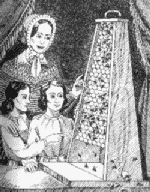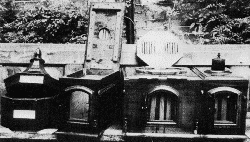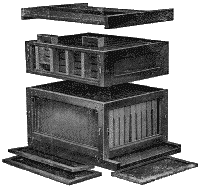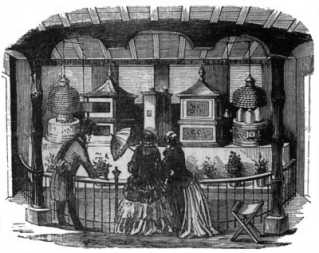John's Beekeeping Notebook
A Taste of American Beekeeping History - Page 5
Observation Bee Hives
Honey bees have fascinated people for centuries, and people have built many types of hives to observe them.
The woodcut at right shows a woman observing bees through a window in an elaborate observation hive.
The scene at left shows a Ukrainian observation hive from about 1840.
Thomas Nutt built an elaborate observation hive in the 1830's. The center section of his hive housed the brood nest, and the bees stored honey on either side. The hive also had a hollow wooden floor with drawers for feeding the bees.
Several of Langstroth's hives from the 1850's and 1860's had glass walls installed for observation. The Langstroth hive at right is fitted with many glass jars and bells for the bees to fill with honey. The bees would need to be very crowded before filling those jars!
Forcing bees to build comb inside glass jars is a common theme for observation hives.
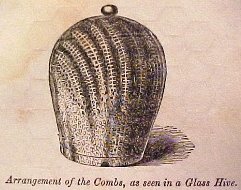
The glass bell on the left has a wood frame inside for the bees to attach their comb. Without a wood frame, the bees will readily attach comb to the glass.
Bees will build comb in glass jars on top of standard hives, too, if the bees are crowded. The hive at right is a fancy skep with three jars on top. The jars are normally covered.
The bees' natural comb-building, without frames, is very interesting. I highly recommend that curious beekeepers build an un-framed hive at least once for the learning experience. This hive on the left is a natural comb hive from the late 1800's.
Alfred Neighbour built many observation hives in the 1870's, including the hive at left. The hive at right is a simple adaptation using standard frames and comb sections.
Neighbour also established an observation beehive building at a zoological garden for the public to view bees.
The wall-mounted hive at right has a well-designed entrance. It pivots against the wall when not being viewed. This drawing is from a book published 1905.
I hope these pictures give you some ideas!
Reference sources: Mysteries of Bee-keeping Explained, Quinby, 1866, Langstroth on the Honey-Bee, 1860 & 1884, Gleanings in Bee Culture magazine, 1890, ABC of Bee Culture, 1895, 1913, 1929 & 1945, American Bee Journal, 1900, The Observation Hive, Showler, 1978, and Ukrainian Beekeeping, 1998.
